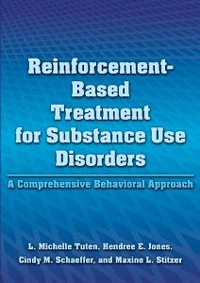“Reinforcement-Based Treatment for Substance Use Disorders”

“Reinforcement-Based Treatment for Substance Use Disorders”
L. Michelle Tuten, Hendree E. Jones, Cindy M. Schaeffer, and Maxine L. Stitzer
American Psychological Association
Washington, D.C. 2012
Insights provided in treating challenging population
Reviewed by James K. Luiselli, Ed.D., ABPP, BCBA
Substance use disorders are a serious public health problem. Professionals recognize that effective treatment must be comprehensive, time-efficient, individualized and culturally sensitive. Medication detoxification, pharmacotherapy and self-help programs are common treatment modalities but they rarely function successfully as stand-alone interventions and frequently produce mixed results.
This book describes Reinforcement-Based Treatment (RBT), an empirically supported, positively focused, and multi-procedural model for treating substance use disorders. Designed as an intensive outpatient service, RBT concentrates on incentives for abstinence, relapse prevention, extensive case management and community outreach.
RBT was originally developed for opiate (heroin) abusers but has since been extended to marijuana, cocaine and alcohol dependence.
Essentially, the book is a treatment manual for implementing RBT. The format is a series of clinical guidelines that the authors formulated and evaluated in several clinical trials and research projects. The primary intended audience is clinicians working in substance abuse treatment centers as well as administrators who have discretion over the types of procedures within their agency.
Ultimately the book promises to provide “a strong foundation in the latest behavioral and motivational influences for substance use disorders, how they are delivered in real-world practice settings and their application to specialized client populations.”
As described in the book’s introductory chapter, there are several core clinical features of RBT. One overriding principle is making treatment a positive experience by eliminating confrontational and judgmental exchanges with clients in favor of a strengths-based approach that seeks to increase contact with non-substance using activities.
Readers will quickly see that RBT is fundamentally grounded in operant conditioning, applied behavior analysis and social learning theory.
The layout of the book features individual chapters that outline each of the core clinical features of RBT in greater detail. These chapters are truly impressive, rich with clinical acumen, pragmatic recommendations and research illustrations. For example, the authors describe how to engage productively with reluctant clients, perform functional behavioral assessment, establish treatment goals, monitor outcome and adapt to implementation challenges among many other salient concerns.
These chapters are enhanced with several examples of process and outcome documentation forms.
The book also shines in its coverage of large-scale systems issues that impact substance users and their responsiveness to treatment. On this topic, the authors offer strategies for interacting with significant others and family members, training and supervising treatment staff and addressing the unique needs of pregnant women and parents in the child welfare system. They even consider the not-to-be neglected financial demands of implementing RBT, notably purchasing incentives and paying for urine screens, recreational activities and program counselors.
You will not find a better book in the contemporary literature about treating substance use disorders. Most impressive is the solid research-to-practice translation that permeates every page. Just considering individual chapters would be instructive – however, understanding RBT is best accomplished by reading the book in entirety. I suggest that regardless of your orientation, “Reinforcement-Based Treatment of Substance Use Disorders” will give you new insight into what works best with this most challenging clinical population.
James K. Luiselli, Ed.D., ABPP, BCBA-D, is senior vice president, applied research, clinical training and peer review at the May Institute in Norwood, Mass.
Learn more about the book: Reinforcement-Based Treatment for Substance Use Disorders: A Comprehensive Behavioral Approach
